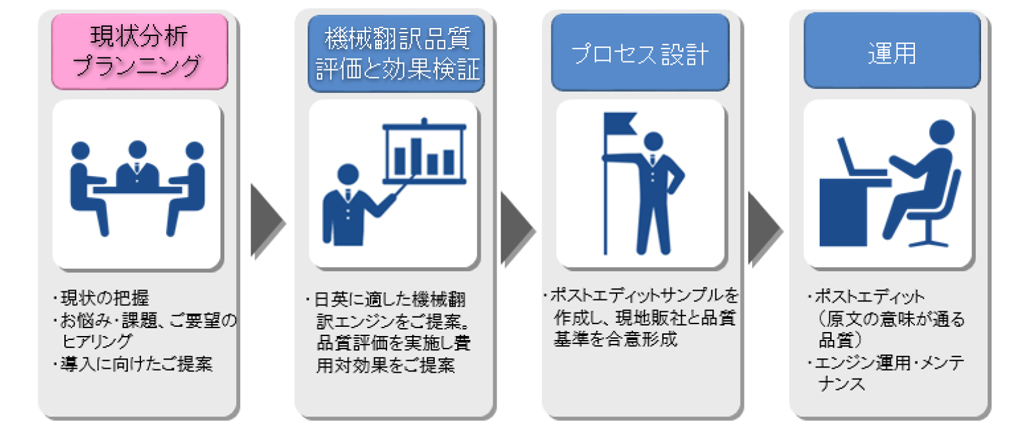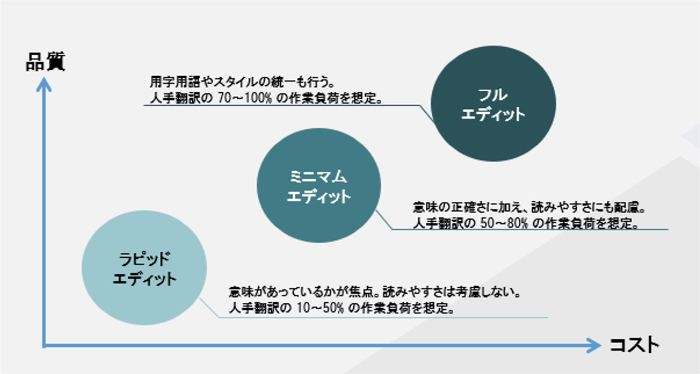Customer Requests

This client, being a foreign-affiliated company, had already implemented machine translation for translations from English to European languages. However, when they attempted to introduce machine translation for Japanese-English translations using the same engine as for European languages, they experienced poor quality, which ultimately led to increased costs and labor, resulting in failure.
Therefore, our company proposes a machine translation engine suitable for Japanese-English translation and has supported the implementation of post-editing. As a result, we have successfully reduced the translation costs and lead time from Japanese to English by 40% compared to traditional human translation.
Solutions of Human Science
At Human Science, we have provided the following consulting services to successfully implement machine translation in Japanese-English translation.

In this project, we supported the implementation of machine translation through the following steps.
1. Proposal for a machine translation engine suitable for Japanese-English translation
The strengths of machine translation engines vary by language and field. For example, even when translating the same document, the quality can differ significantly depending on the machine translation engine used. Therefore, when introducing machine translation, it is very important to select a machine translation engine that is suitable for the target document and language. This time, ・I don't want to spend much on the operational costs of the machine translation engine.・There is no existing translation data such as translation memories.・For support content, the quality of the translation can be somewhat unnatural as long as the meaning is conveyed accurately. Based on the customer's request, we proposed a suitable machine translation engine for Japanese-English translation from multiple candidates. After conducting quality verification and cost-effectiveness calculations with the proposed engine in advance, we confirmed that the introduction of machine translation would be effective and officially implemented it.
②Setting Quality Standards
To successfully implement machine translation, it is also important to establish the target quality standards in advance for the post-editing process, which involves correcting the translated text after machine translation, known as "post-editing." By setting quality standards in advance, you can prevent excessive quality or excessive costs during the post-editing process. The following diagram shows the correlation between the target quality standards and the three levels of revisions in post-editing.
This time, we received a request from the client stating that "since the target is support content, the quality of the translation can be somewhat unnatural as long as the meaning is accurately conveyed." Therefore, we decided to implement post-editing at the "Rapid Edit" level, which requires the least amount of correction for machine translation. In "Rapid Edit," we do not make corrections from the perspective of readability, so as long as the meaning is accurately conveyed, we will not make corrections even if there are somewhat unnatural expressions or terms. We have implemented post-editing under this policy and provided the results as samples for our clients to review, confirming that we have achieved the desired quality.
Implementation of Post-editing
In implementing post-editing, we compiled the correction points at the level of 'Rapid Edit' into a checklist, clarified the quality standards and correction points, and conducted post-editing after sharing them with the responsible parties.
Customer Feedback
“
I was greatly helped by the fact that the Japanese-English machine translation, which I had previously implemented and struggled with, has become smooth.
I had given up on machine translation for Japanese-English translation, thinking it was difficult because it failed using the same machine translation engine as European languages. However, I realized that by using an engine suitable for the target language, machine translation can be utilized even for Japanese-English translation.
We can reduce the costs and lead times for Japanese-English translation of support content, which has been recognized by our US headquarters.
We are considering the introduction of machine translation for other content, such as internal documents and user manuals, in addition to support content.
"
From Human Science representatives

This is an example of how we supported the introduction of machine translation for Japanese-English translation. By selecting the optimal engine and thoroughly conducting quality verification and setting quality standards in advance, we were able to achieve a reduction in translation costs and lead times even for Japanese-English translation through the implementation of machine translation. From those who have participated in our seminars and conferences ・"Is it possible to implement machine translation for Japanese to English translation?"・"Are there any examples of implementing machine translation in Japanese-English translation?" We often receive inquiries about this, and even for Japanese-English translation, it is entirely possible to achieve cost reduction and shorten the translation period by using machine translation. In the future, we are considering the introduction of machine translation for internal documents and user manuals, so we would like to continue working together on designing processes tailored to each specific document.





